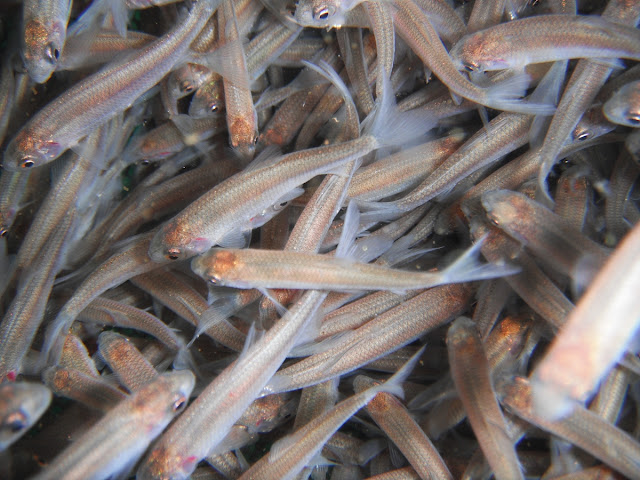I must apologise for the
unusually long time between the last and this blog post… I’m sure you are all
used to the inconsistencies of reporting this project, so I want to keep it
within what you are familiar with, which starts with an apology for nothing,
then lots of squeaky words describing the unhealthy number of images you are
looking at…
I must admit to being distracted by the vacuum of Facebook which has been sucking up fairly regular bite-sized updates on the ARP FB page, but thought I’d blend them all together and give an update here on recent events as spring hurtles towards us.
Late autumn and early winter see the usual maintenance jobs being dealt with as we wrestle our Bickton site back from Mother Nature; starting with the clearance of our feeder stream that had been stifled by rush and sedge growth which was impeding the flow of our water.
Dickie Howell came along and helped for the afternoon and soon we had all our allocated water getting to where it is needed – feeding our stews. Bloody hard work, but with plenty of tea and biscuits and nattering, the job is soon done.
Shortly after, it was the turn of the lake, and over three afternoons with help from Steve Percival and Chris Harrison, the willows were taken back to the stumps and the rush beds cleared. The lake is, after all, a part of the fish farm set-up so needs to be as clear as we can keep it for when we net it.
The lead-up to Christmas and New Year is always at a different pace than the second day and thereafter of January as time starts passing at an alarming rate when minutes go by in seconds and suddenly there seems so much to do and no time.
It was intended to get an early start and ahead of the game by having this years’ health checks done in December which unfortunately had to be postponed as Shaun Leonard, the man doing the checks came down with suspected Weil’s Disease and was wiped out.
Fortunately, he recovered nicely and the fish were netted from one of the stews and delivered to him in early January. The netting and delivery of the thirty poor unfortunates was once again done by the EA guys, Jim Allan and Phil Rudd. And, the good news is they passed the health check, so that clears us for this years’ annual ‘Roach Dump’ into the Avon which will take place in late March, as usual in three different locations along the river.
Then as January fizzles out it’s time to evacuate the tanks at Project HQ and decant the roach into the stews at Bickton, apart from the one tank of one year olds we split between two long tanks to spend an additional year here. It’s all about spreading and hopefully reducing the risk element.
This is when Project HQ (my lovely garden with its putting green lawns) turns into the Somme. There is mud, pipes, pumps, mud, buckets, mud, fish poo, mud, mud and mud everywhere… Seems all I have is one whopping great water feature/swamp.
On a very serious note, and just before I let the pictures tell the rest of the story (like you haven’t scrolled down to here in the past two seconds)… This project has been going for a decade now and in all that time there have always been varying levels of success in terms of egg survival, hatch rate, growth and numbers making it to one year old, and we have agonised about the possible reasons, like health of adult spawners, pre-spawning winter conditions, early spring warmth, then summer conditions, food availability…. ZZZzzzz!!!!... Yeah, I know…, but have never been able to pinpoint what makes a good or bad year – Well, it’s happened again… This year is set to be the best in the project’s history… And I have absolutely no idea why… But I love it!... I’m sure I’ll find some boffinism when I write it all up in the book though…
Now to the pictures… Hope you like.
 |
|
It is always good to see how vibrant and healthy they all
are. We drop them into a barrel for the executioner to make his selections.
|
 |
|
It’s also very nice to see how well the few that evaded the
netting three years ago have grown on. These will be put into the lake where
they’ll play their part in that element of the project.
|
 |
|
Up at the stews the roach are lowered in to join their
cousins from last year. You’d think they’d bomb off as fast as they can but, in
fact, they simply mosey off casually.
|
 |
|
I just kept poking the camera closer to each net of fish and
hoped for the best. It’s impossible to gauge the angle and focus and distance accurately.
It’s just pot-luck.
|
 |
|
Fortunately, they didn’t all shower past the lens the moment
the net was lowered into the water.
|
 |
|
In a week or so, when the water turns green, that’ll be the
last I see of them for a year, unless they die.
|
 |
|
This is one of the best of them actually being lowered just
under the surface and bombing off to explore their new home… where they might
be a bit disappointed.
|
 |
|
Reports of folks catching roach throughout the river continue
to come through with increasing regularity; some with pictures and wonderful
messages of appreciation for the project.
|
 |
|
I’ve even managed a few myself…
|













Made me smile for a number of reasons, all good. Wonderful work, well done!
ReplyDeleteBrilliant work I look forward to seeing some on my line in a few years😀
ReplyDelete